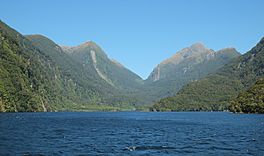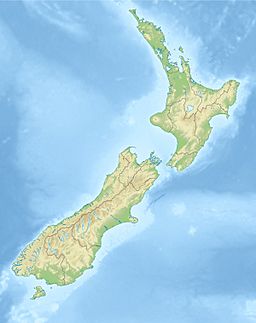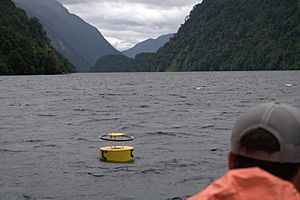Deep Cove (New Zealand) facts for kids
Quick facts for kids Deep Cove |
|
|---|---|

Deep Cove, with Wilmot Pass behind
|
|
| Location | Tasman Sea |
| Coordinates | 45°27′S 167°09′E / 45.450°S 167.150°E |
| Native name | Taipaririki (Māori) |
| River sources | Lyvia River |
| Basin countries | New Zealand |
| Max. length | 4 km (2.5 mi) |
| Max. width | 500 m (1,600 ft) |
| Surface area | 1 km (0.62 mi) |
| Settlements | Deep cove hostel |
Deep Cove (called Taipaririki by the Māori people) is a beautiful part of Doubtful Sound. Doubtful Sound is a long, narrow bay on the southwest coast of New Zealand's South Island. Deep Cove is one of the most distant parts of Doubtful Sound from the Tasman Sea. It is about 32 kilometers (20 miles) from the main ocean. Deep Cove itself is about 4 kilometers (2.5 miles) long. It is famous for its stunning waterfalls, like Helena Falls and Lady Alice Falls.
Exploring Deep Cove
For a long time, Deep Cove could only be reached by boat or by walking a track over Wilmot Pass. But in the 1960s, things changed a lot. Deep Cove became a key part of the Manapouri Hydroelectricity Project. This project uses water to make electricity.
A long tunnel, about 10 kilometers (6 miles) long, was built. This tunnel connects Deep Cove with Lake Manapouri. Water from the lake flows through this tunnel to the power station. The first tunnel was finished in 1969. The power station started working the next year. A second tunnel was built later, from 1997 to 2002.
The power station releases fresh water into Deep Cove. This fresh water can affect the plants and animals in the area. However, this region naturally gets a lot of rain. About 7.6 meters (25 feet) of rain falls here every year.
Today, Deep Cove is a popular spot for tourists. Many boat tours of Doubtful Sound start here. These tours often begin in Manapouri. Visitors take a boat across Lake Manapouri, then a bus over Wilmot Pass. After the boat tour in Doubtful Sound, they return the same way.
The wharf in Deep Cove is also important for the power station. Large equipment, like transformers, are brought here by barges. They are then taken over Wilmot Pass to the power plant. This is because there are no other roads to the power station.
Plants and Animals
Deep Cove is home to many different kinds of wildlife. You might see dolphins swimming in the water. Many types of birds also live in this area.
Some animals, like mice, rats, and hares, have been brought here by people. The land around Deep Cove is covered in thick forests. These forests have many Nothofagus (beech) trees. There are also many different kinds of shrubs and ferns growing on the forest floor.
See also
 In Spanish: Deep Cove (Nueva Zelanda) para niños
In Spanish: Deep Cove (Nueva Zelanda) para niños



